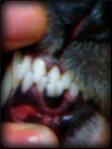Dental Healthcare for Puppies and Kittens
2010 February 4
tags: base narrow teeth, bone cysts in dogs, cat dentistry, Cats, crossbite, dental x-rays, Dogs, impacted puppy teeth, malocclusion, pet dentistry
by Doc Truli
Dental Healthcare starts as a Puppy and Kitten
No kidding! Your precious pup or kitten needs to be assessed right from the start for oral health status. Some life-long problems can be prevented as young as 8 weeks old!
Checklist for Baby Visits:
- Occlusion means how the teeth come together when the mouth is closed. Young animals can have overbite (top jaw longer than bottom), underbite (bottom longer than top, like in Bulldogs), crossbite (a mix, see picture), or certain other abnormalities.
- Surgery at a very young age, before 12 weeks old when the permanent incisors (front teeth) come in, can save your pet from a lifetime of toothaches.
- Canine Teeth (the biggest “eye” teeth in the four corners of the front of the mouth) must erupt in proper position, or your dog could have pain until expensive corrective oral surgery is performed.
- Sometimes, the canine tooth on the mandible (bottom jaw) will start coming in on the inside of the baby tooth. This is called Base Narrow. This situation will cause the permanent tooth to poke up into the roof of the mouth when your dog grows up. It is fixed by removing the retained canine teeth at about 5-6 months’ old.
“A tooth is defined as retained when the permanent tooth can just start to be seen budding through the pink gingival lining of the jaw. Do not wait to remove the deciduous (baby) tooth, or your pet will suffer the consequences,” warns Doc Truli.
- Missing Teeth: all dogs, except hairless Chinese Crested Dogs and their fluffy Powderpuff relatives, have 28 baby teeth and 42 permanent teeth. Cats have 26 baby teeth and 30 permanent teeth.
“Dogs have 28 baby teeth and 42 adult teeth. Cats have 26 baby teeth and 30 adult teeth.”
“Why are Missing teeth a problem?” you’re probably asking yourself!
- Well, if the tooth is impacted or unerupted, an ever-growing bone cyst, or fluid-filled pocket can form around the tooth out of site inside the jaw. Over time, it keeps growing and can eat away 100% of the jaw, cause eventual loss of all the teeth and a rubbery, useless jawbone! So there. Convinced you should get it checked out? (Unfortunately, not kidding.)
- A dental x-ray shows if the tooth is hidden in the jaw and if a cyst has started. Surgery to remove the tooth and/or the cyst results in full recovery. Obviously the sooner this condition is fixed, the better.
from → Cats, Dogs, Pet Dental Success Stories, Pet Health
2 Responses
leave one →




Thank you for this very important information. Because of you I just took my pup for his first check up, all is well so far with Turbo’ teeth!
First of all–cool site for dog stuff. I like the free bag of treats with an order. You never know which treats will become a dog’s fave!
I’m going to guess Turbo is either an imaginary dog so you could comment and get a link on VirtuaVet, or, maybe, Turbo is related to those fab gorgeous Great Danes I see there in your banner. So, Riddle me this: is Turbo a Great Dane?